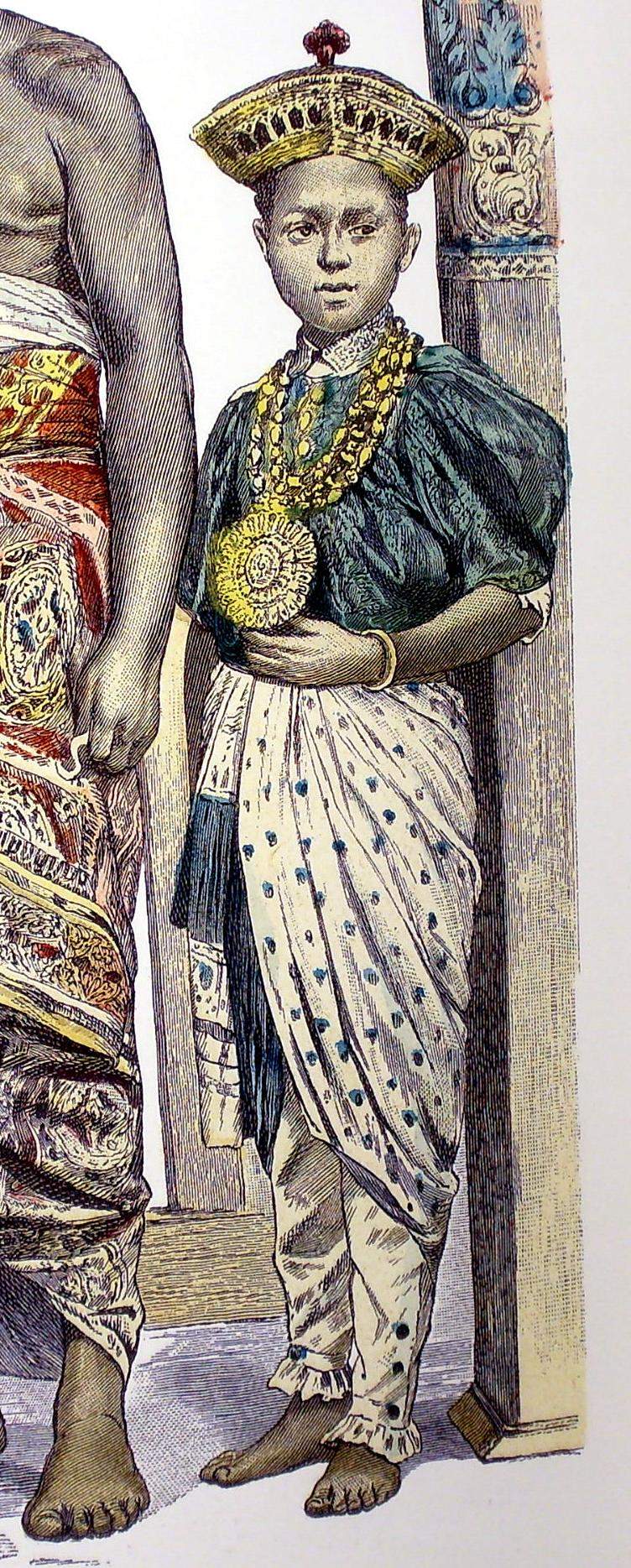
Sri Lanka: Traditional Clothing

Figure 1.--A German illustrator drew this image of a Sinalese boy in the late-19th century. The hat and jewelry suggest tht he was a royal or aristocratic boy. We think that the illustrator was depicting an actual boy in the late-19th century. Note the boy is wearing a blouse like garment with balooning sleeves and pants. This may be a western influence, but we are not sure. Source: 'Costumes of All Nations' (First Munich Artists, London, 1901).
|
|
There is some information avilable on traditional clothing which share many similarities with southern India. A factor here is the Tamil population, an ethnic group inhabiting southern Indua and northern Sri Lanka. Traditionally people generally went topless, both men and women. Here climate was factor. They might draped clothing over their chests and shoulders, but they mostly went topless. This changed with the arival of the Portuguese (16th century). European Christians, first the Portuguese and then the Dutch, were disturbed by the open display of women's breasts. Thus gradually women and girls began covering up. Thus traditional styles were influenced by the Europeans, although European sensibilities had less impact on trditional male clothing. And after the British seized control (19th century), Western clothing gradually became increasingly common--especially for children. While Western clothes became widely worn in the 20th century, colorful traditional styles remained very popular with women and girls when dressing up. We note Sri Lankans wearing a variety of traditional clothing. There are destinctive garments for men and women. We see women wearing a variety of garments. Marital status and ethnicity appear to be factors in what women wear. The saree/sari is the principal traditional female garment. The sarong is the principal male male traditional garment.
Cronological Trends
There is some information avilable on traditional clothing which share many similarities with southern India. A factor here is the Tamil population, an ethnic group inhabiting southern Indua and northern Sri Lanka. Traditionally people generally went topless, both men and women. Here climate was factor. They might draped clothing over their chests and shoulders, but they mostly went topless. This changed with the arival of the Portuguese (16th century). European Christians, first the Portuguese and then the Dutch, were disturbed by the open display of women's breasts. Thus gradually women and girls began covering up. Thus traditional styles were influenced by the Europeans, although European sensibilities had less impact on trditional male clothing. And after the British seized control (19th century), Western clothing gradually became increasingly common--especially for children. While Western clothes became widely worn in the 20th century, colorful traditional styles remained very popular with women and girls when dressing up.
Garments
We note Sri Lankans wearing a variety of traditional clothing. There are destinctive garments for men and women. We see women wearing a variety of garments. Marital status and ethnicity appear to be factors in what women wear. Women one they are of marital age or alreasy married wear a sari, called a kandyan sari. A sari/saree is commony very colourful. Women and girls wear them whjen dressing up to special occassions like weddings and parties. Some women wear them for day to day activities like shopping. Elderly women wear them more than yonger more modern women. Girls wear a kind of half saree. This is a cloth and jacket, often with a frill around the shoulders. Tamil girls wear a destinctive pavadai sattai. This is essenially a patterned skirt worn with a blouse. Young Tamil women might wear a half sarre's which is a kind of combination between a sarre and a pavadai sattai. As it is not a full saree, it is worn with a long scarf or other textile on the left shoulder and is then tucked into the skirt at the waistline. Sinhalese men wear a sarong and shirt called baniyama. The sarong is a long piece of cloth, which men wrap around the waist, somewhat like a towel. It is done long enough to actually reach the feet. The sarong is often worn without any top. Unlike the sari, the sarong is not a formal garment, at leasr in modern Sri Lanka. Men wear the sarong mostly at home nd to some extent for everyday activities such as work. Men for special occassions now commonly wear Western dress. Tamil men wear patta vetty. This is a Western shirt with a long cloth wrapped around their waist, rather like a sarong. Boys do not commonly wear tradutiinal clothing. They are more likely to wear casyual Western clothing.
HBC

Navigate the Boys' Historical Clothing Web Site:
[Introduction]
[Activities]
[Biographies]
[Chronology]
[Clothing styles]
[Countries]
[Bibliographies]
[Contributions]
[Essays]
[FAQs]
[Glossaries]
[Images]
[Links]
[Registration]
[Tools]
[Boys' Clothing Home]
Navigate the Boys' Historical Clothing national pages:
[Return to the Main Sri Lankan page]
[Return to the Main Asian country page]
[Return to the Main country barefoot page]
[Return to the Main countries page]
[Afghanistan]
[Armenia]
[China]
[India]
[Japan]
[Korea]
[Malaysia]
[Pakistan]
[Taiwan]
[Tajikistan]
[Uzbeckistan]
Created: 4:17 AM 11/21/2011
Last updated: 4:17 AM 11/21/2011



